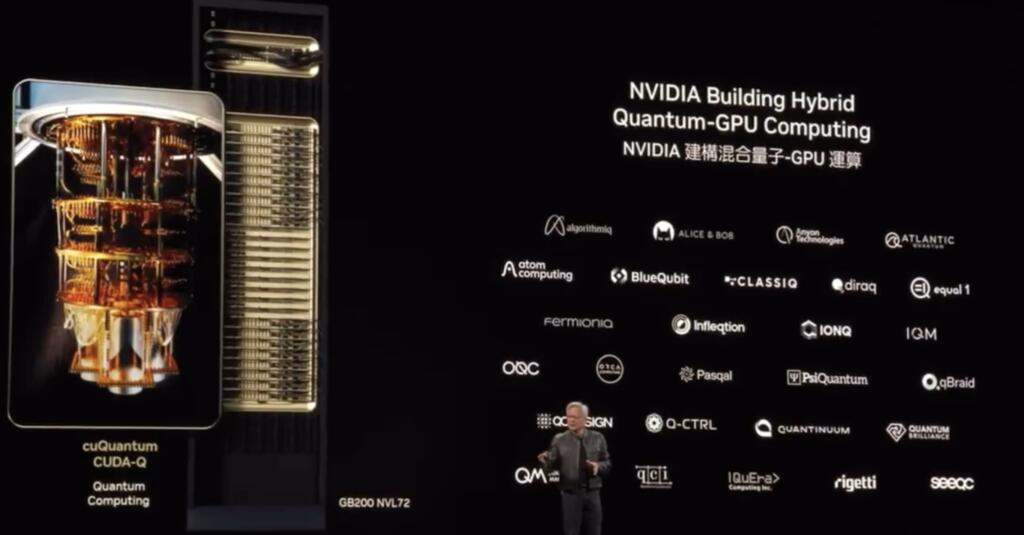Now Reading: Nvidia ASIC and Quantum Integration Ultra Blackwell and AI Developer Servers
-
01
Nvidia ASIC and Quantum Integration Ultra Blackwell and AI Developer Servers
Nvidia ASIC and Quantum Integration Ultra Blackwell and AI Developer Servers

Highlights of NVIDIA Computex 2025 Announcements
1. DGX Spark: Personal AI Supercomputer
Description: The DGX Spark is a compact, personal AI supercomputer designed for developers, researchers, and data scientists. It brings high-performance AI capabilities to a desktop-friendly form factor.
NVIDIA GB10 Grace Blackwell Superchip will deliver 1 Petaflop for and DGX spark personal AI server.
It includes 128GB of unified system memory (LPDDR5X).
Supports AI models with up to 200 billion parameters for local development and inference.
Preloaded with the NVIDIA AI software stack (e.g., PyTorch, Jupyter).
ASIC chips and Quantum Systems Integration
ASIC chiplets can now be integrated onto Nvidia chips with NVLINK Fusion connections. At Computex 2025, NVIDIA unveiled significant advancements in ASIC chiplet integration, most notably through the introduction of NVLink Fusion. This new technology builds on NVIDIA’s high-speed interconnect ecosystem, NVLink, and enables industries to create semi-custom AI infrastructure by integrating custom ASICs or CPUs with NVIDIA’s powerful GPUs.
Key Features of NVLink Fusion
High-Speed Connectivity: NVLink Fusion leverages NVIDIA’s NVLink technology, known for its high bandwidth and low latency, to ensure seamless communication between integrated chiplets, including custom ASICs and NVIDIA GPUs.
Flexibility: It allows companies to pair NVIDIA processors with their own custom CPUs or ASICs, offering a modular approach to building tailored AI systems without sacrificing the benefits of NVIDIA’s advanced computing architecture.
Scalability: This integration supports the scale-up of custom silicon for demanding AI workloads, such as large-scale model training and agentic AI inference.
Industry Partnerships
NVIDIA has collaborated with several leading companies to bring NVLink Fusion to life:
MediaTek, Marvell, Alchip Technologies, Astera Labs, Synopsys, and Cadence:
Implications of ASIC Chiplet Integration
NVIDIA’s advancements in ASIC chiplet integration have far-reaching implications across multiple industries:
AI Performance: By combining specialized ASICs with NVIDIA GPUs, companies can achieve greater efficiency and performance for AI-specific tasks, such as real-time inference or large model training.
Customization: NVLink Fusion enables semi-custom designs, allowing industries to tailor hardware to their exact needs—whether for data centers, edge computing, or automotive applications.
Market Impact: This technology positions NVIDIA to strengthen its dominance in the AI computing market by fostering collaboration with ASIC specialists and offering scalable, adaptable solutions.
Applications: Potential use cases include:
Data Centers: Enhanced AI processing power for cloud-based services.
Automotive: Improved real-time AI for autonomous vehicles, where power efficiency is critical.
Industrial: Custom AI solutions for specialized workloads in manufacturing or healthcare.
Hybrid Quantum was announced. NVIDIA launched the NVIDIA Accelerated Quantum Research Centre (NVAQC) in Boston, Massachusetts, to tackle challenges in quantum computing, such as qubit noise and experimental quantum chip design.
Ultra Blackwell Chips: Blackwell Ultra GPUs
Description: The Blackwell Ultra GPUs, including the B300, represent NVIDIA’s next-generation AI accelerators, designed for AI factories and advanced AI workloads as part of an annual release cadence.
Features:
The B300 offers a 1.5x performance boost over standard Blackwell GPUs.
Provides 15 PFLOPS of dense FP4 compute and 30 PFLOPS with FP4 Tensor Cores.
Equipped with 288GB of HBM3e memory.
Powers platforms like the GB300 NVL72 (72 GPUs) and HGX B300 NVL16 (server-class unit).
Power and Specs:
Power: High power consumption (likely exceeding 600W per GPU), requiring data center infrastructure with advanced cooling.
Specs: 15 PFLOPS FP4 compute, 288GB HBM3e memory, optimized for large-scale AI tasks.
DGX Station
A more powerful desktop supercomputer with the GB300 Grace Blackwell Ultra Desktop Superchip.
Offers 20 petaflops of AI performance and 784GB of unified memory.
Suitable for enterprise use as a standalone or centralized compute node.
Spectrum-X and Quantum-X Networking:
New networking platforms leveraging silicon photonics to reduce energy use and support larger GPU clusters.
RTX Pro Blackwell GPUs:
GPUs for PCs and servers combining AI and graphics capabilities for professional users.
NVIDIA Dynamo:
An open-source inference framework to enhance the performance of reasoning models on NVIDIA GPUs.
HIGHLIGHTS
NVIDIA’s Computex 2025 announcements showcase a diverse portfolio catering to different needs: the DGX Spark empowers individual developers with desktop AI capabilities, the NVAQC advances quantum computing research with data center-scale power, and the Ultra Blackwell chips drive next-generation AI factories with unparalleled performance. Each product’s power and specification requirements align with its intended use case, from standard desktop setups to high-performance data center environments, solidifying NVIDIA’s leadership in AI and computing innovation.










Brian Wang is a Futurist Thought Leader and a popular Science blogger with 1 million readers per month. His blog Nextbigfuture.com is ranked #1 Science News Blog. It covers many disruptive technology and trends including Space, Robotics, Artificial Intelligence, Medicine, Anti-aging Biotechnology, and Nanotechnology.
Known for identifying cutting edge technologies, he is currently a Co-Founder of a startup and fundraiser for high potential early-stage companies. He is the Head of Research for Allocations for deep technology investments and an Angel Investor at Space Angels.
A frequent speaker at corporations, he has been a TEDx speaker, a Singularity University speaker and guest at numerous interviews for radio and podcasts. He is open to public speaking and advising engagements.




















